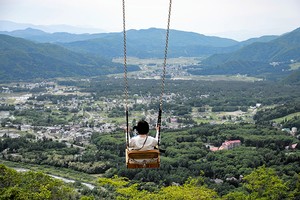By LISA VOGT/ Special to Asahi Weekly
November 21, 2023 at 08:00 JST
 Itsukushima shrine’s torii gate rises from the Seto Inland Sea. This iconic site is what first greets visitors arriving by ferry from the mainland. The torii’s pillars are made from 500- to 600-year-old camphor trees that are naturally resistant to rot and insects. When the tide is low, it is possible to walk right up to the gate itself. (Photo by Lisa Vogt)
Itsukushima shrine’s torii gate rises from the Seto Inland Sea. This iconic site is what first greets visitors arriving by ferry from the mainland. The torii’s pillars are made from 500- to 600-year-old camphor trees that are naturally resistant to rot and insects. When the tide is low, it is possible to walk right up to the gate itself. (Photo by Lisa Vogt)
I’m red-faced. All this time, I had assumed that Aki-no-Miyajima meant that the best season to visit Miyajima is in the autumn, with the mountain foliage turning colorful hues of red, orange and yellow.
I just learned that Aki, however, is the old name of a province in the Chugoku region of Honshu that comprises Hiroshima Prefecture today. I wonder if I’ve conjured up false ideas about Matsushima island and Amanohashidate, too.
And it didn’t hit home for me that Miyajima and Itsukushima were the same place. Alternate names kept coming up as I tried to find my way to the registered UNESCO site documented as the Itsukushima Shinto shrine.
I’d ask people for directions and end up getting more confused until it dawned on me that “shrine island” is what many people call the place listed on maps as “strict island.”
In ancient times, the whole island was considered a god and too sacred for commoners to set foot upon. Births or deaths were believed to taint the land, and to keep it pure even today, pregnant women are expected to seek refuge on the mainland as their delivery day draws near.
This practice is shared by those who are seriously ill or the elderly whose time is near. Naturally, the island maintains its tradition of not permitting burials, either.
Legend traces the shrine’s origins back to the year 593 during the reign of Empress Suiko, but it was Taira no Kiyomori (1118-1181), a general of the Heian Period (794-1185), who gets the credit for playing a significant role in making Itsukushima shrine what it is today.
Miyajima is famous for the 16-meter iconic vermillion torii gate made of camphor that seemingly floats on the water when the tide is high. Back in the olden days, pilgrims had to steer boats through it to approach the shrine, which also was constructed on the sea.
Why not put the gate on land? It could have stemmed from the belief that Itsukushima, itself, is a deity to revere and, therefore, should not be defiled. Perhaps it was based on the notion of creating a likeness of the mythical Ryugu-jo (Dragon Palace) since goddesses of seas and storms are enshrined there.
Or maybe it was a manifestation based on the belief that as people passed away, their souls would embark on a boat to “gokuraku” paradise (Buddhist Pure Land). We will never know for sure, but in any case, true to its reputation, Itsukushima is mesmerizingly beautiful and a must-see for everyone.
* * *
This article by Lisa Vogt, a Washington-born and Tokyo-based photographer, originally appeared in the Sept. 17 issue of Asahi Weekly. It is part of the series "Lisa’s UNESCO World Heritage Sites in Japan," which depicts various sites of outstanding universal value across the country through the perspective of the author, a professor at Aoyama Gakuin University.




















A peek through the music industry’s curtain at the producers who harnessed social media to help their idols go global.
A series based on diplomatic documents declassified by Japan’s Foreign Ministry
Here is a collection of first-hand accounts by “hibakusha” atomic bomb survivors.
Cooking experts, chefs and others involved in the field of food introduce their special recipes intertwined with their paths in life.
A series about Japanese-Americans and their memories of World War II